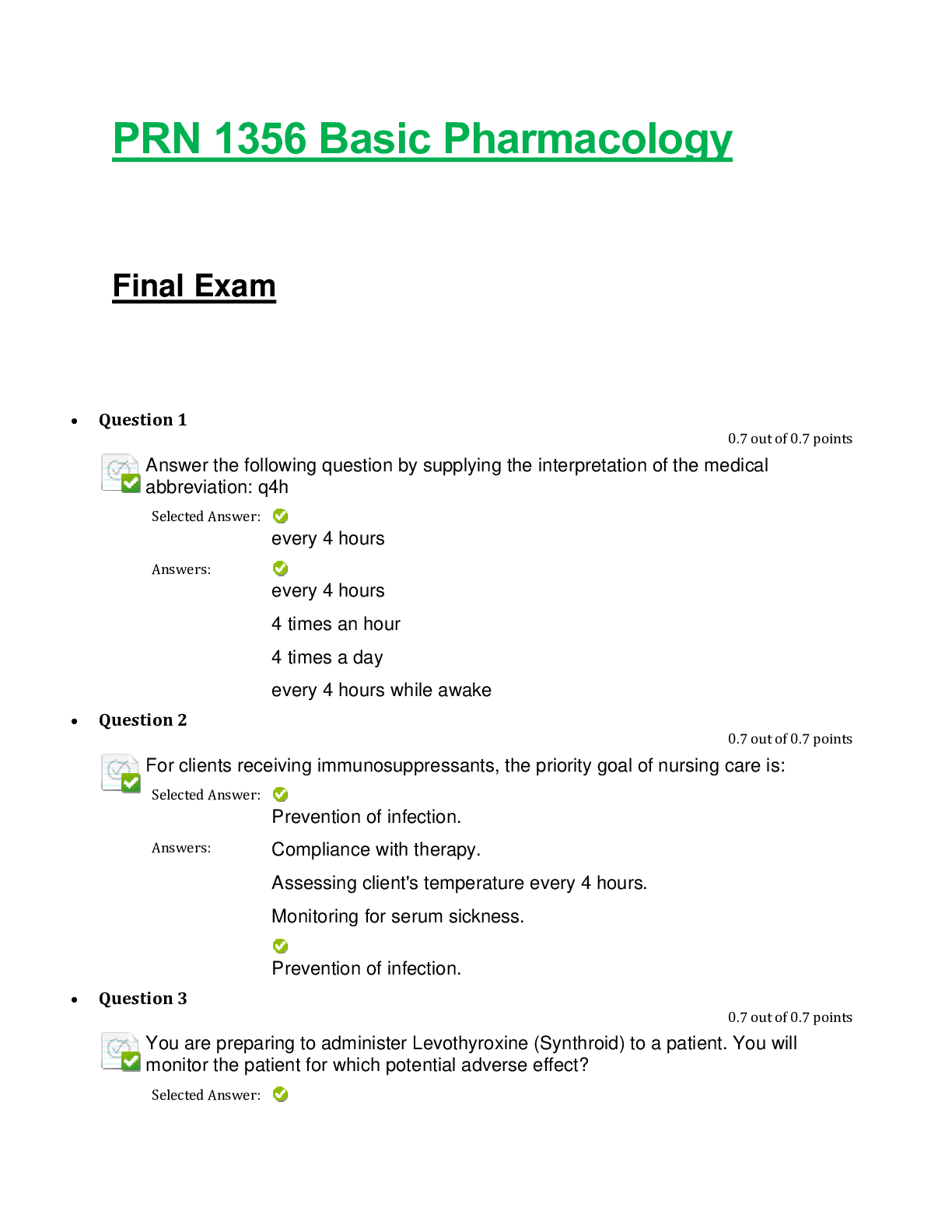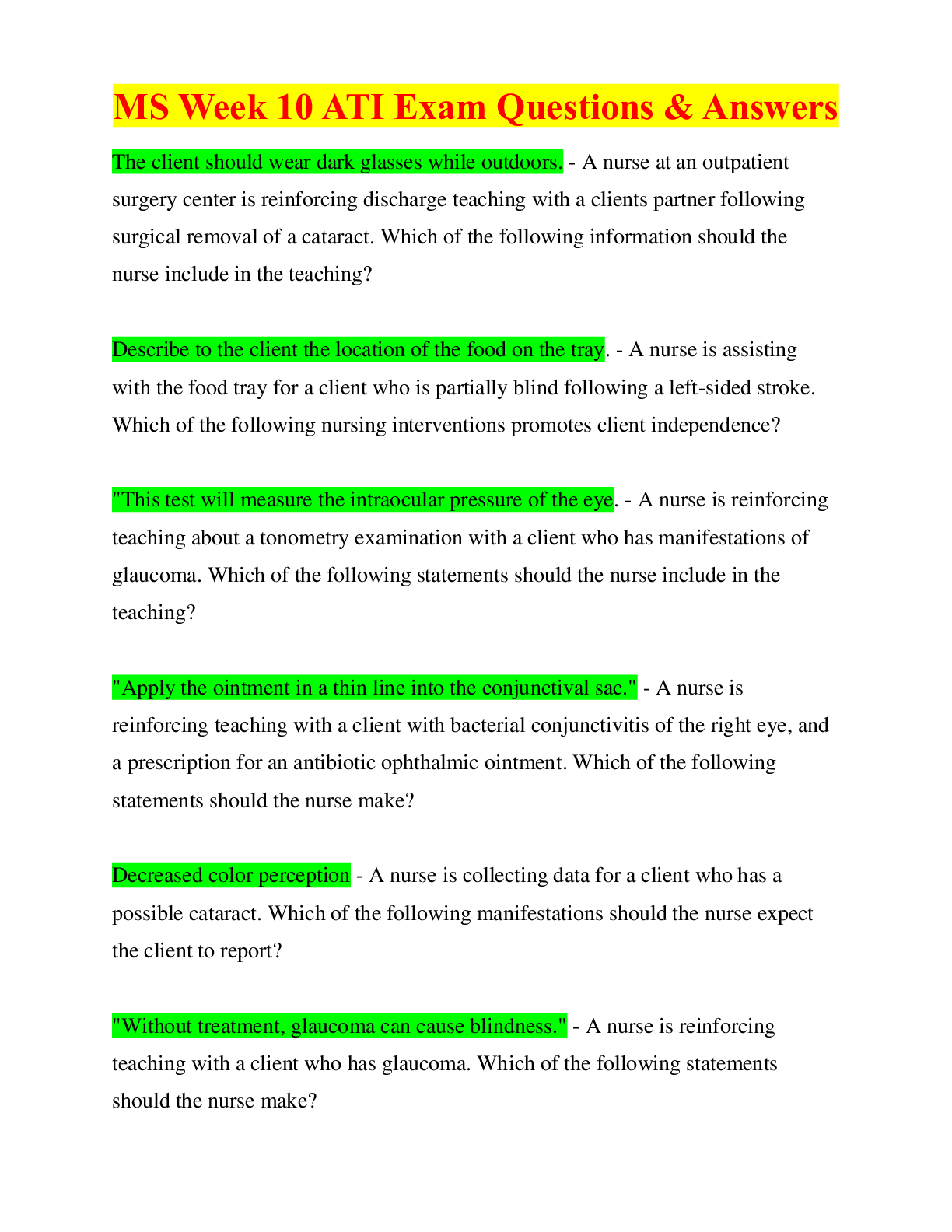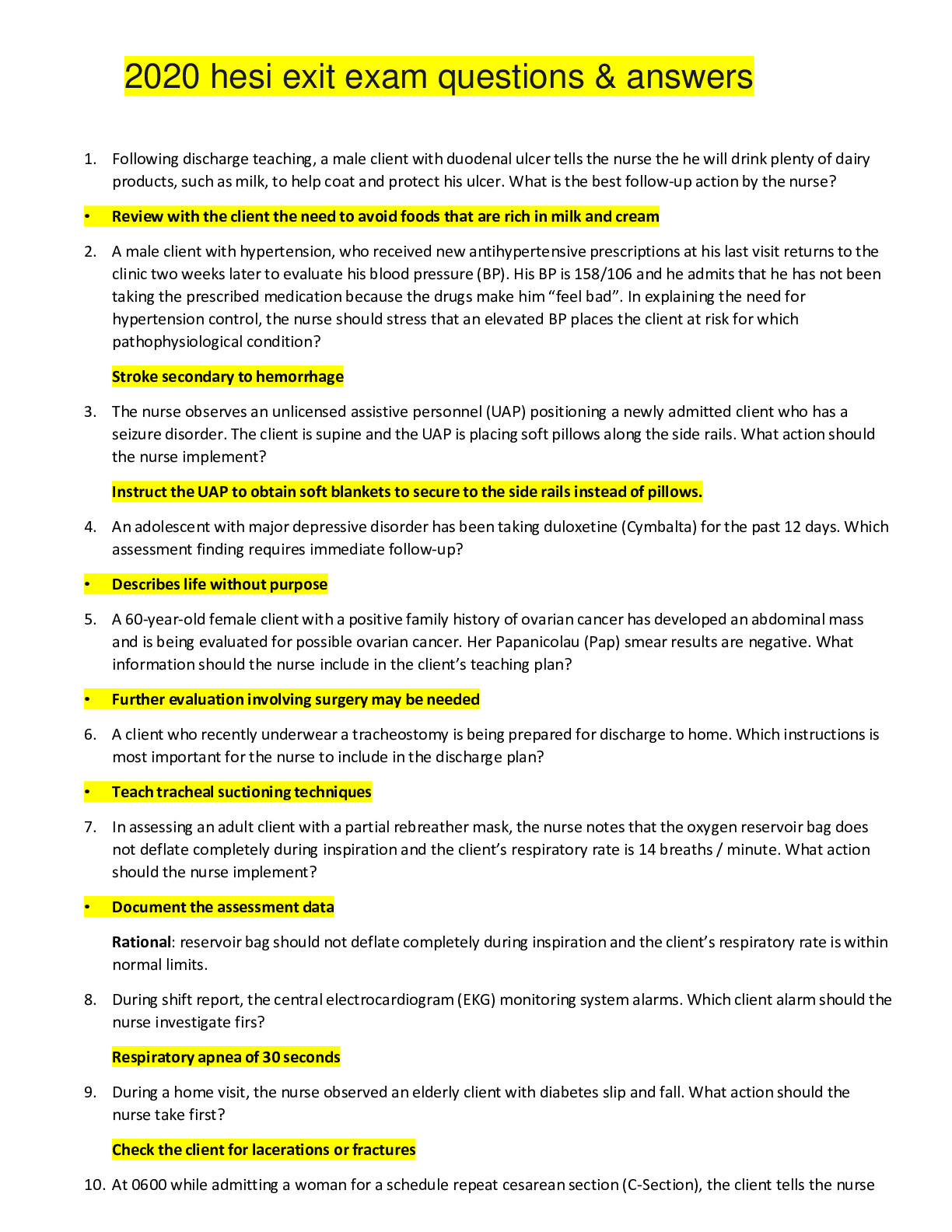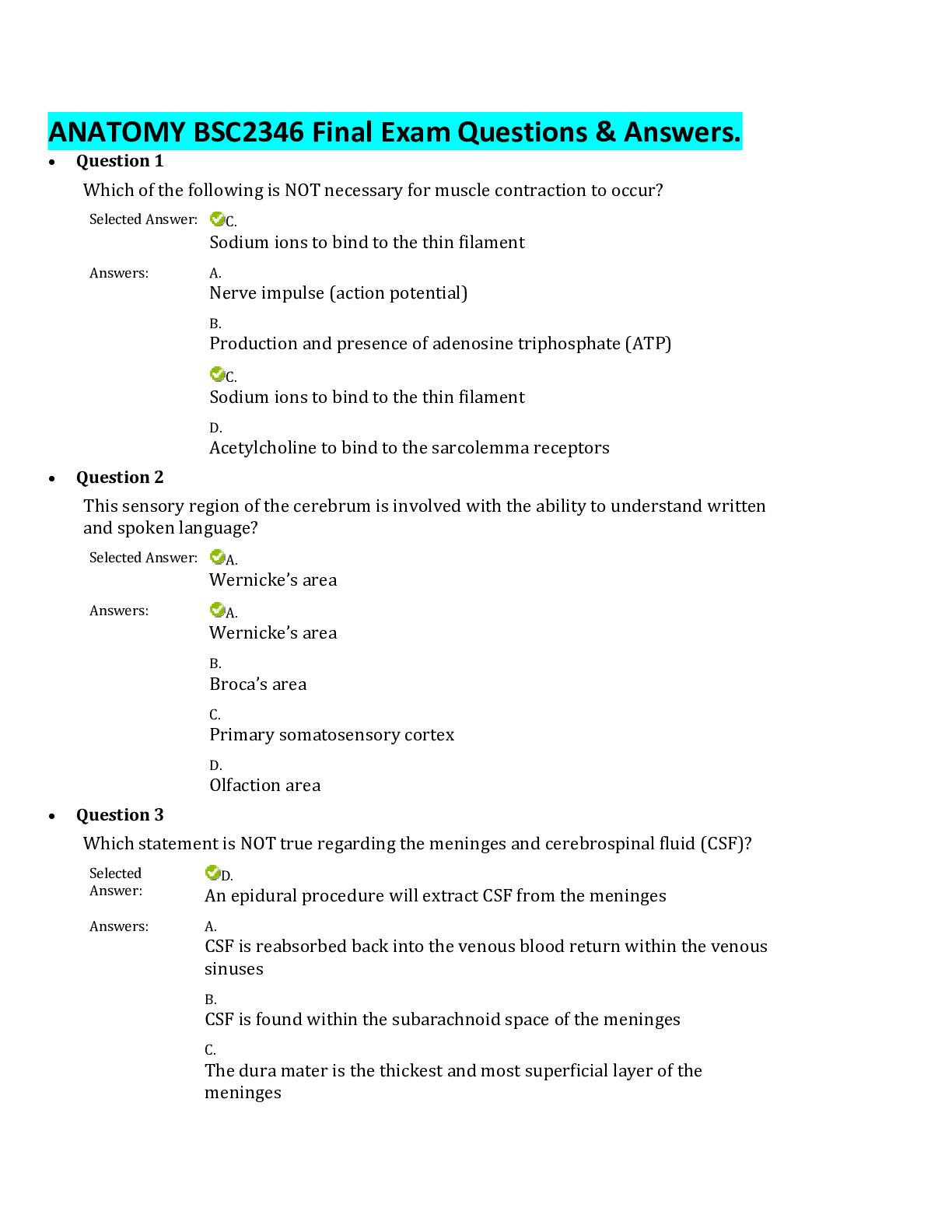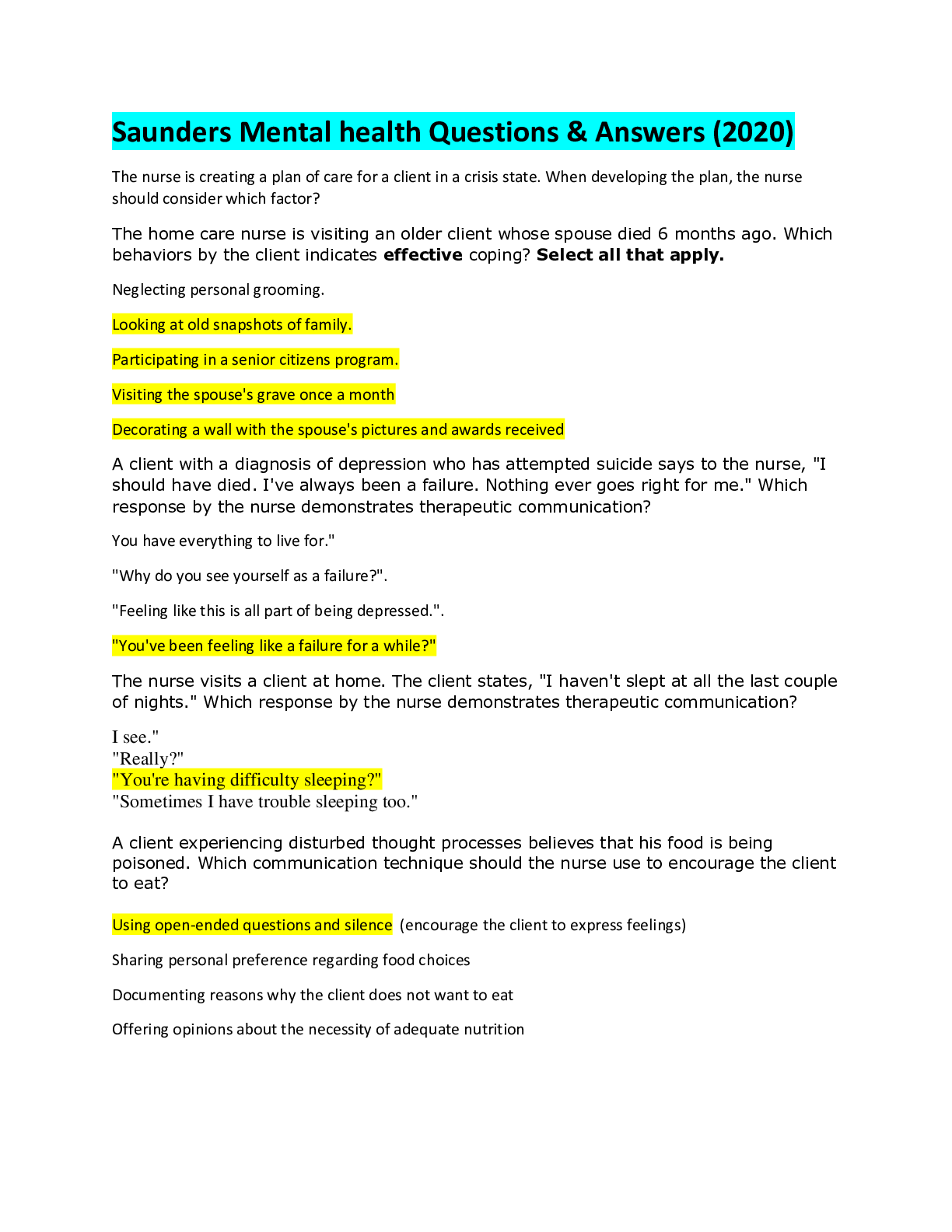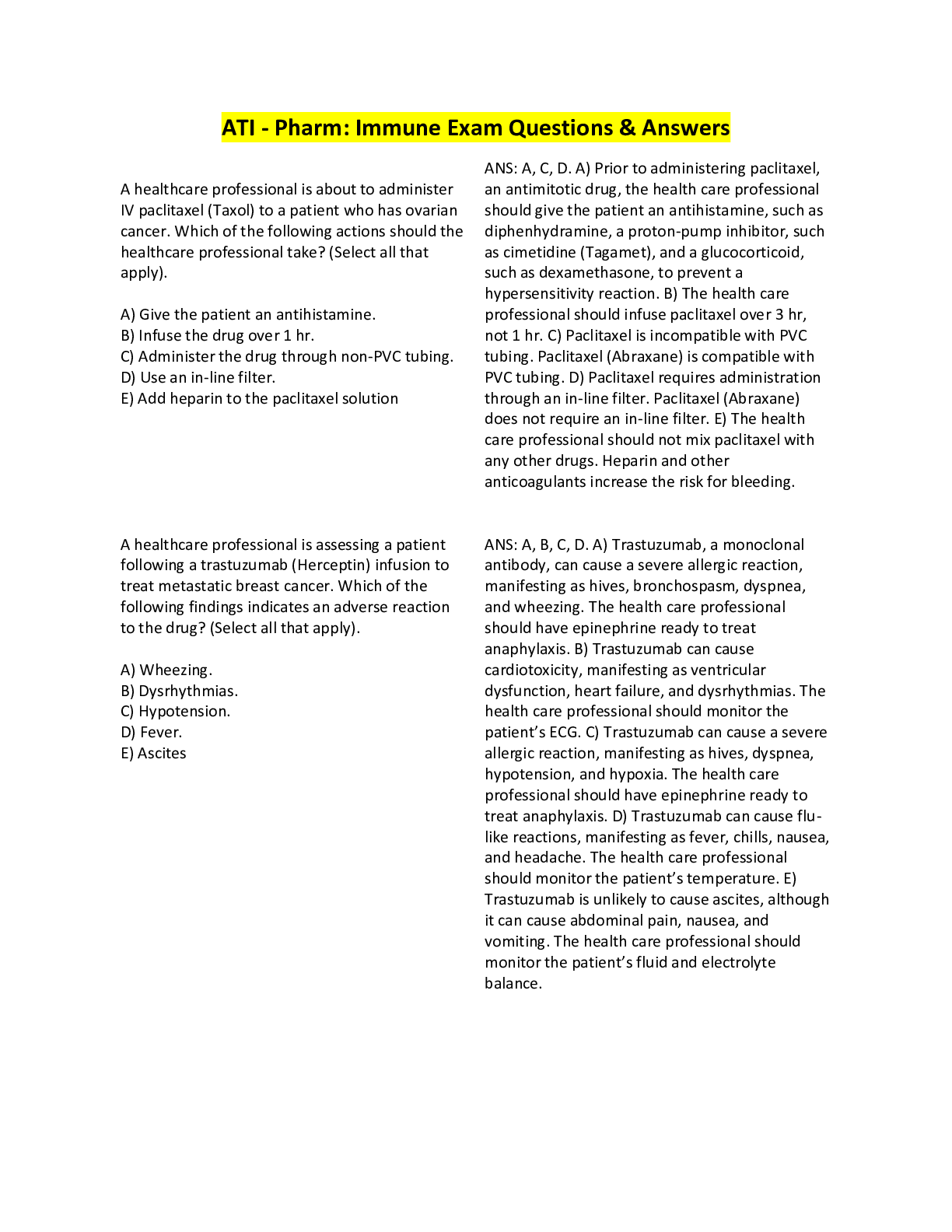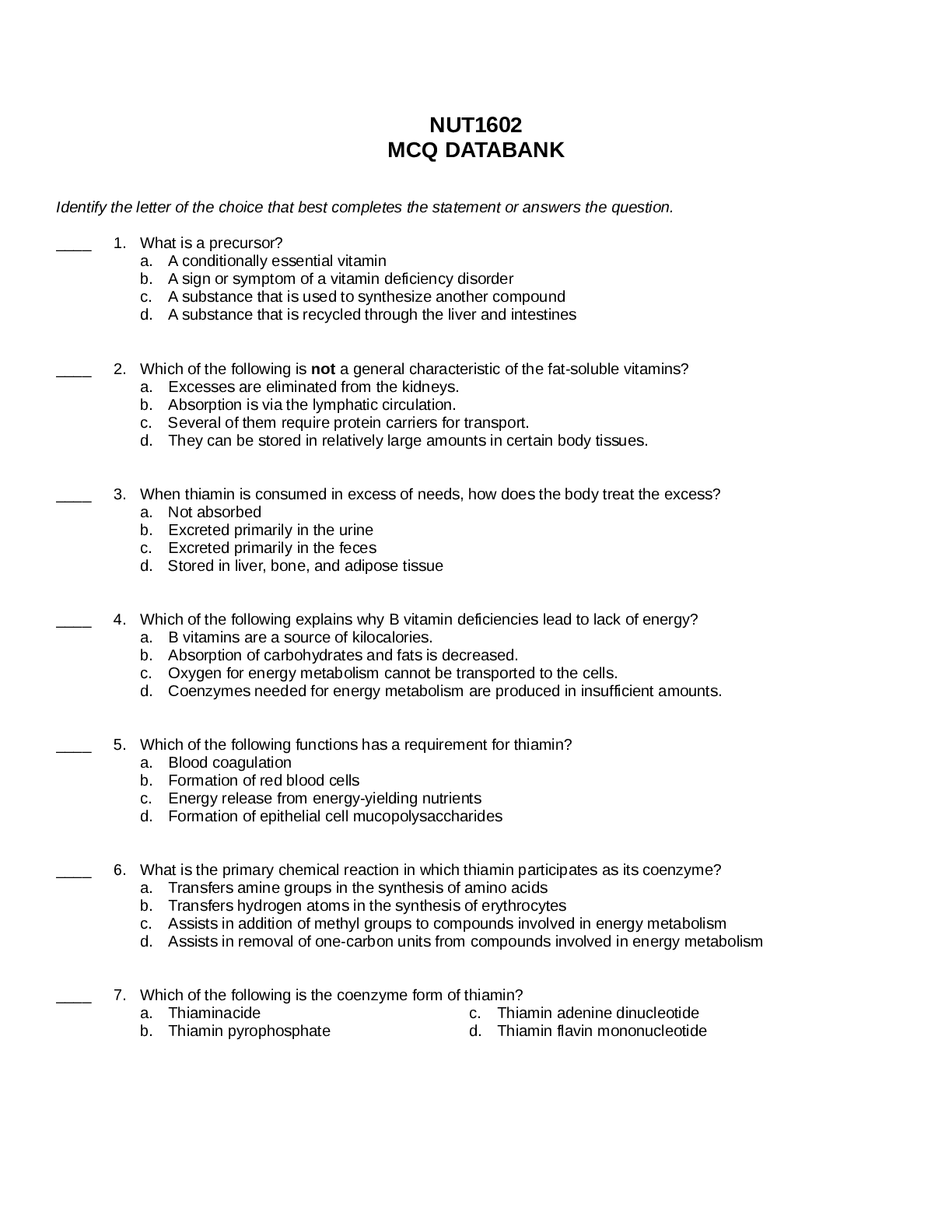NSG5002 FINAL EXAM QUESTIONS & ANSWERS,100% CORRECT
Document Content and Description Below
As patients that entrust our care to another individual, we always expect honesty to avoid leading us down a deceptive pathway in our healthcare decisions. Adherence to which principle compels provide... rs to be truthful? Question 1 options: a) Fidelity b) Veracity c) Self-reflection d) Finance Save Question 2 (2.75 points) What purpose does the principle of fidelity serve in the provider/patient relationship? Question 2 options: a) Ensures that patients receive whatever they want b) Maintains costs in the healthcare arena c) Obligates the provider to a one-on-one relationship with the individual d) Ensures that providers honor their commitments to the patient Save Question 3 (2.75 points) We all know that collaboration is integral to becoming a successful nurse practitioner. Among collaborations, however, only one can be considered as the most important. While each example below is important, which is the most important collaboration? The one that occurs: Question 3 options: a) Between the patient and the nurse practitioner b) Between the patient and their family c) Between two healthcare providers about a single patient d) Between the nurse practitioner and their physician mentor Save Question 4 (2.75 points) Chronic, non-communicable diseases account for disproportionate costs to the healthcare system. According to the World Health Organization, what percent of preventable deaths and disabilities occur in the Americas related to chronic non-communicable diseases? Question 4 options: a) 80%-90% b) 10%-15% c) 35%-45% d) 60%-70% Save Question 5 (2.75 points) Improvements in the delivery and management of healthcare are necessary if we are to improve the overall health of this nation’s population. Which of the following are identified in your readings as strategic in the movement to improve the healthcare system? Question 5 options: a) Population management and healthcare practice b) Monetary savings and limited disruption in healthcare delivery c) President and Congress d) Socialized medicine and governmental controls Save Question 6 (2.75 points) Encouragement of patients to take effective actions in their own healthcare refers to the concept of: Question 6 options: a) Physician or provider-driven care b) Family care givers c) Self-management support d) Interprofessional support Save Question 7 (2.75 points) Population disease management is a term used to describe: Question 7 options: a) Low prevalence specific diseases b) High prevalence specific diseases c) High specificity disease states d) Low specificity diseases states Save Question 8 (2.75 points) Changes in Medicare are a method the government uses to make changes to reimbursement schedules for healthcare. Currently, Medicare reimburses nurse practitioners for all services, even those deemed to be exclusive to nursing? Question 8 options: a) True b) False Save Question 9 (2.75 points) Medicare covers inpatient hospital services under which part of the Medicare insurance? Question 9 options: a) Part B b) Part D c) Part C d) Part A Save Question 10 (2.75 points) Medicare hospital insurance (Part A) is funded through what system? Question 10 options: a) State income taxes b) Federal payroll taxes c) Federal income taxes d) Interest from investments Save Question 11 (2.75 points) Medicaid is mandated to be provided by each state through federal codes. Each state must offer Medicaid exactly as the federal government prescribes. Question 11 options: a) True b) False Save Question 12 (2.75 points) Eligibility for Medicaid includes the following: Question 12 options: a) Very young and elderly only b) Children and women regardless of income c) Elderly, children and women living in poverty d) Everyone unemployed Save Question 13 (2.75 points) Narrowed coronary arteries or plague rupture within the arteries of the coronary system may directly cause which condition? Question 13 options: a) Diabetes b) Coronary artery disease c) Venous Statis d) Hypertension Save Question 14 (2.75 points) What happens to coronary flow related to CAD? Question 14 options: a) Hyper profusion of the myocardium b) Hypo profusion of the myocardium c) Functional systolic pressures d) Cerebral vascular infarction Save Question 15 (2.75 points) In CAD, after both systolic and diastolic dysfunction have occurred, the typical pattern of chest pain and related EKG changes occur. During an EKG, you should expect to see ST-segment and T-wave changes that are central to demonstration of ischemia occurring relatively late in the ischemic cascade. Question 15 options: a) True b) False Save Question 16 (2.75 points) What is considered the first-line initial approach to test for CAD? Question 16 options: a) EKG b) Echocardiogram c) Cardiac Catheterization d) Exercise Stress Test Save Question 17 (2.75 points) What are two of the most common forms of Exercise Stress Tests used today? Question 17 options: a) Unicycle and Running in pace b) Bicycle and treadmill c) Bicycle and rowing machine d) Thallium and Dobutamine Save Question 18 (2.75 points) Maintenance of an Isometric ST-segment during exercise is the response of? Question 18 options: a) A normal heart b) An abnormal heart c) CAD d) Hypo profusion Save Question 19 (2.75 points) By standard criteria, how is a positive stress test defined? Question 19 options: a) Development of a horizontal or down sloping ST-segment depression of 1mm b) Development of a horizontal or down sloping ST-segment depression of 10mm c) Upward sloping ST-segment measured at the J point of the QRS d) Down sloping of the ST-segment at the J point of the QRS Save Question 20 (2.75 points) Your patient underwent an exercise stress test for CAD. There is significant elevation of the ST-segYour patient underwent an exercise stress test for CAD. There is significant elevation of the ST-segment. What do you need to know about these changes to manage your patient’s care?Your patient underwent an exercise stress test for CAD. There is significant elevation of the ST-segment. What do you need to know about these changes to manage your patient’s care?ment. What do you need to know about these changes to manage your patient’s care? Question 20 options: a) These changes are predictive of myocardial infarction b) This patient needs to see someone more experienced in treatment of CAD c) These changes predict dire outcomes d) These changes have minimal predictive value for CAD Save Question 21 (2.75 points) After completion of the exercise stress test, you would measure the ST-segment depression after the J point of the QRS. The J point is located where in relation to the QRS? Question 21 options: a) Junction between P and R b) Junction between QRS and ST segment c) After the H point d) Immediately after the P wave Save Question 22 (2.75 points) What ECG changes can reduce the specificity of the ETT? Question 22 options: a) Paced rhythm and resting bundle branch block b) Exercise induced bundle branch blocks c) Paced rhythm and exercise induced bundle branch blocks d) Low voltage up sloping of the ST-segment Save Question 23 (2.75 points) Why would inability to exercise reduce the specificity of the routine ETT? Question 23 options: a) Produces persistent ST-segmental changes and T-wave abnormalities b) Produces QRS changes that cannot be interpreted c) Causes ST-segment changes and P-wave abnormalities d) Will not produce any changes in ECG Save Question 24 (2.75 points) The sensitivity of a routine ETT is effort dependent. What physiological changes occur during effort in the routine ETT? Question 24 options: a) Decrease in coronary blood flow b) Decreased heart rate and increased systolic blood pressure c) Rapid heart rates and coronary artery narrowing d) Increased coronary flow and increased systolic blood pressure Save Question 25 (2.75 points) Specifically, when is an ETT considered to be negative? Question 25 options: a) Patient exercises to 85% of age predicted maximum heart rate without evidence of induced ischemia b) Patient exercises until tired without evidence of induced ischemia c) Patient has ST-segmental changes with down sloping of greater than 1 mm at 50% of age-predicted maximum heart rate d) Patient exercises to 20% maximum age-predicted heart rate without induced ischemia Save Question 26 (2.75 points) Your mentor says that you should be prepared to know how to determine the maximum heart rate for your patient during the ETT. How is the age-predicted maximum heart rate during an ETT determined? Question 26 options: a) 120-age b) 220-age c) 65+age d) 220+age Save Question 27 (2.75 points) Your patient has a maximum age-predicted heart rate of 180. During the exercise, he reaches a heart rate of 140 and then states he can no longer exercise. You see no evidence of ischemia on the ECG. This would be diagnostic for what condition? Question 27 options: a) Diagnostic for impending Myocardial Infarction b) Predictive of no CAD c) Diagnostic of laziness d) Has no diagnostic value to rule out CAD Save Question 28 (2.75 points) Your patient has a maximum age-predicted heart rate of 180. During the exercise he reaches a heart rate of 140 and then states he can no longer exercise. You see evidence of ischemic changes on the ECG. This would be predictive of what condition? Question 28 options: a) Significant CAD b) Low risk of CAD c) Impending death d) Stroke Save Question 29 (2.75 points) Ischemic changes on ECG during ETT is highly predictive of CAD. What is another important strong predictor of CAD that you might see during an ETT? Question 29 options: a) Exercise-induced hypotension b) Exercise-induced hypertension c) Rapid heart rate d) Slow heart rate Save Question 30 (2.75 points) The leads on the ECG showing ischemic changes during or immediately after an ETT can correlate roughly to the culprit artery or arteries with significant CAD. Question 30 options: a) True b) False Save Question 31 (2.75 points) What do you know regarding ischemia that is confined to only the posterior and or lateral segments of the left ventricle? Question 31 options: a) Easier to detect by ETT b) Difficult to detect by ETT c) Requires both for detection of changes by ETT d) ETT cannot be used for detection Save Question 32 (2.75 points) Your practice partner just ordered an exercise echocardiography 2DE for a patient with suspected cardiovascular risk. This patient has known resting wall motion abnormalities. Why would this not be the best test to assess this patient’s cardiac risk? Question 32 options: a) Sensitivity is increased b) Sensitivity is decreased c) Specificity is increased d) Specificity is decreased Save Question 33 (2.75 points) You are considering adding an adjunctive form of testing to detect wall motion abnormalities during the ETT. You select Echocardiography as the added testing. You choose this test because you know that echocardiography does what when added to a standard ETT? Question 33 options: a) Enhances sensitivity and specificity of CAD detection b) Enhances sensitivity while reducing specificity of CAD detection c) You like pretty pictures of wall motion d) Enhances specificity while not changing sensitivity of detection for CAD Save Question 34 (2.75 points) On the echocardiography during the ETT you notice the following change: abnormal left ventricular ejection fraction. What do these changes suggest related to this patient? Question 34 options: a) Non-ischemic changes of the baseline ECG b) Ischemia of the myocardium c) Weak ventricular muscles d) Rise in heart rate without evidence of ischemia Save Question 35 (2.75 points) Your patient cannot sit on a bicycle and has difficulties walking a treadmill with limited capacity for exercising. Still, you know that the ETT is the preferred test for CAD. You consider adding a pharmacological agent to get to maximum heart rate. What agent would be the most commonly used agent to assist in an ETT? Question 35 options: a) Aspirin b) Epinephrine c) Dobutamine d) Dopamine Save Question 36 (2.75 points) Your patient is morbidly obese and cannot sit on a bicycle or walk a treadmill. She also has marked and severe emphysema. You need to make an assessment of the risk of significant CAD and your patient’s family says that their relative had their diagnosis based on an ultrasound echocardiography. What facts would influence your decision regarding the family request for echo assessment? Question 36 options: a) Sensitivity would be increased because of lung disease b) Specificity would be increased because of obesity c) Sensitivity would be reduced because of obesity and lung disease d) Specificity would be reduced because of obesity and lung disease Save Question 37 (2.75 points) You are in the clinic with your mentor observing the Echocardiogram exercise test of a 45-year old male that has been experiencing slight chest pressure almost daily during exercise. While observing your patient, your mentor points out that the left ventricle wall is thinning and there is some hyperkinesias of the ventricular wall. From your time in the clinic, you know that this test will be considered to be what type of result? Question 37 options: a) Positive b) Negative c) Non-readable d) Impossible Save Question 38 (2.75 points) Of the answers below, which would be included in defining a positive Exercise Echocardiogram? Question 38 options: a) Induced decrease in regional wall motion b) Increase in wall thickening c) Regional hypokensis of ventricular muscles walls d) Death two days after test Save Question 39 (2.75 points) What three conditions definitely alter the results of echocardiography in determining CAD? Question 39 options: a) Diabetes, kidney disease and tooth decay b) Obesity, rapid heart rate and lung disease c) Obesity, slow heart rates and hypertension d) Previous MI, hypotension and diabetes Save Question 40 (2.75 points) Of the following, which is the best answer when asked for an advantage of echocardiogram exercise testing over thallium stress testing? Question 40 options: a) Results are available more quickly b) Does not depend on operator experience c) Costs are the same d) Doesn’t matter because there are no advantages Save Question 41 (2.75 points) Your preceptor decides to add Doppler Flow studies to the echocardiogram exercise test for a patient with a recent history of a holistic murmur best auscultated at the left steral boarder. The patient has no history of cardiac surgeries. He asks you what might be the main advantages of adding Doppler Flow for this particular patient. You know from your readings that there are several reasons to add Doppler Flow and below are listed more than one correct reason. Your best response for this specific case, however, would be that Doppler Flow studies would be of what additive value during the echocardiogram study? Question 41 options: a) Gives better screen shots of wall abnormalities b) Provides assessment of prosthetic valve function c) Detect and evaluate blood shunting from a septal defect d) No advantage is seen for this patient Save Question 42 (2.75 points) What is the leading cause of death for women in the United States? Question 42 options: a) Breast cancer b) Lung cancer c) Heart disease d) Complications of childbirth Save Question 43 (2.75 points) A 47-year old female with general complaints of fatigue and shortness of breath shows up in your clinic as a referral from another nurse practitioner. Several blood tests and chest x-rays have been completed without any diagnosis or outstanding abnormalities. You decide to order an ETT despite the fact that the recent ECG does not show any abnormalities. From the answers below, which would be the best answer to support your decision? Question 43 options: a) Women present with the same pattern of CAD as do males b) CAD in women is under diagnosed c) You are out of other options d) To please the patient Save Question 44 (2.75 points) The diagnostic accuracy of stress testing is decreased among women compared to men for what reasons? Question 44 options: a) Women usually have single vessel or non-obstructive disease b) Women typically have multiple vessel disease c) Women having thinner ventricular and septal muscles d) Women cannot exercise as vigorously as men Save Question 45 (2.75 points) You are counseling a patient diagnosed with stress-induced ischemia. You base your discussion on your knowledge that stress-induced ischemia is thought to be caused by what phenomena? Question 45 options: a) Heart muscle dysfunction b) Diet and exercise c) Endothelial dysfunction of the microvascular d) Too many carbonated drinks Save Question 46 (2.75 points) In women, you need to know the limitations of certain tests for CAD. For example, single-photon emissions CT imaging, while an acceptable test for most men and some women, is technically limited in women for two reasons. From the following, choose the best possible answer. Question 46 options: a) Multiple vessel disease and fat deposits b) Smoking rates and lack of uptake of photons c) Breasts and smaller coronary arteries d) Breasts and fat deposits in abdomen Save Question 47 (2.75 points) A 35 year old female arrives at your clinic. She has had diabetes and peripheral artery disease for the past 5 years. You decide to obtain an ETT. The insurance company argues that this is inappropriate. You justify the ETT because you are planning secondary strategies to prevent future heart disease. Where could one find the supporting data for these guidelines? Question 47 options: a) Framingham risk score b) Medicare guidelines c) Medicaid guidelines d) Do not exist Save Question 48 (2.75 points) A 55-year old man is referred to your clinic. He has been sedentary all of his life, is gaining weight and wishes to get into better physical shape. He has never had any chest pain or shortness of breath when walking or climbing a flight of stairs. Before recommending a vigorous exercise routine for this patient, you order what test? Question 48 options: a) CBC b) Thyroid levels c) Stool samples d) ETT Save Question 49 (2.75 points) All patients, even is asymptomatic, require risk stratification according to the Farmingham risk score. At present, ACC/AHA guidelines, however, do not normally support stress tests for asymptomatic patients without addiitonal justification. From the list below, what could be used to justify a ETT in an asymptomatic patient? Question 49 options: a) Sedentary and wishes to begin aggressive exercise b) A member of congress c) Developmentally challenged d) A smoker of 3 weeks Save Question 50 (2.75 points) For women with known CAD and diabetes, which is most appropriate to assess CAD risk? Question 50 options: a) ETT b) Coronary catheterization c) ETT with imaging d) Coronary bypass surgery [Show More]
Last updated: 1 month ago
Preview 1 out of 14 pages
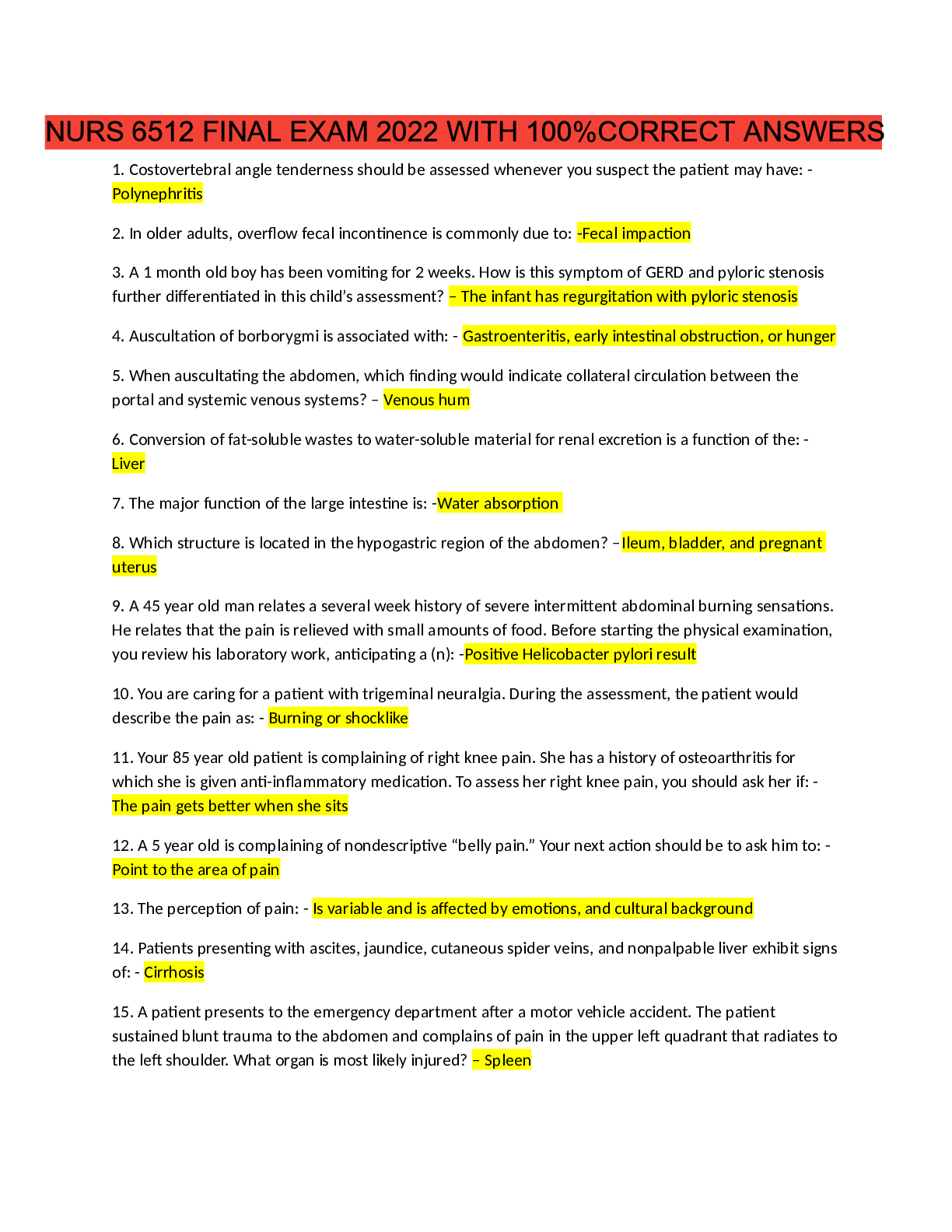
Reviews( 1 )

by joey72 · 3 years ago
Document information
Connected school, study & course
About the document
Uploaded On
Oct 27, 2020
Number of pages
14
Written in
Additional information
This document has been written for:
Uploaded
Oct 27, 2020
Downloads
2
Views
94


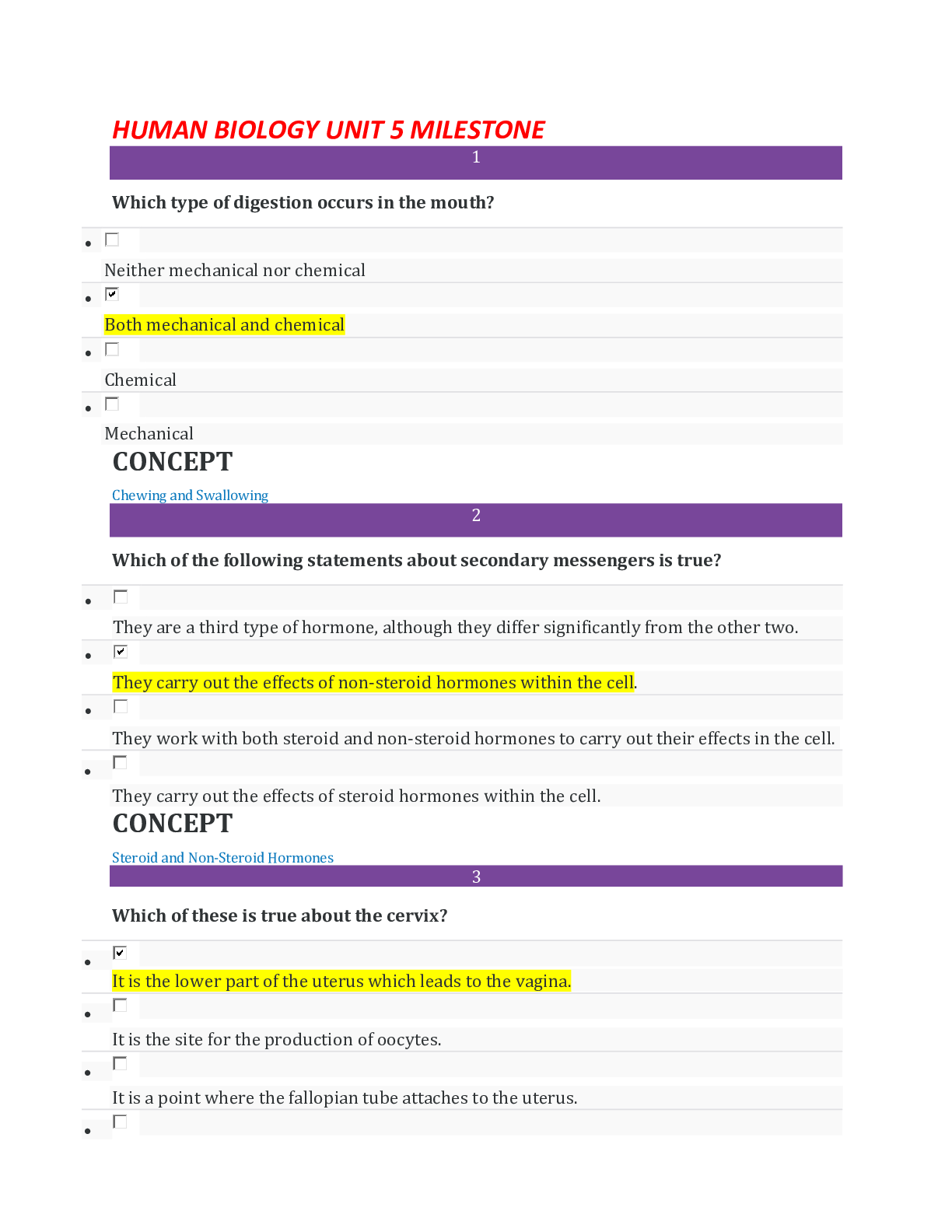











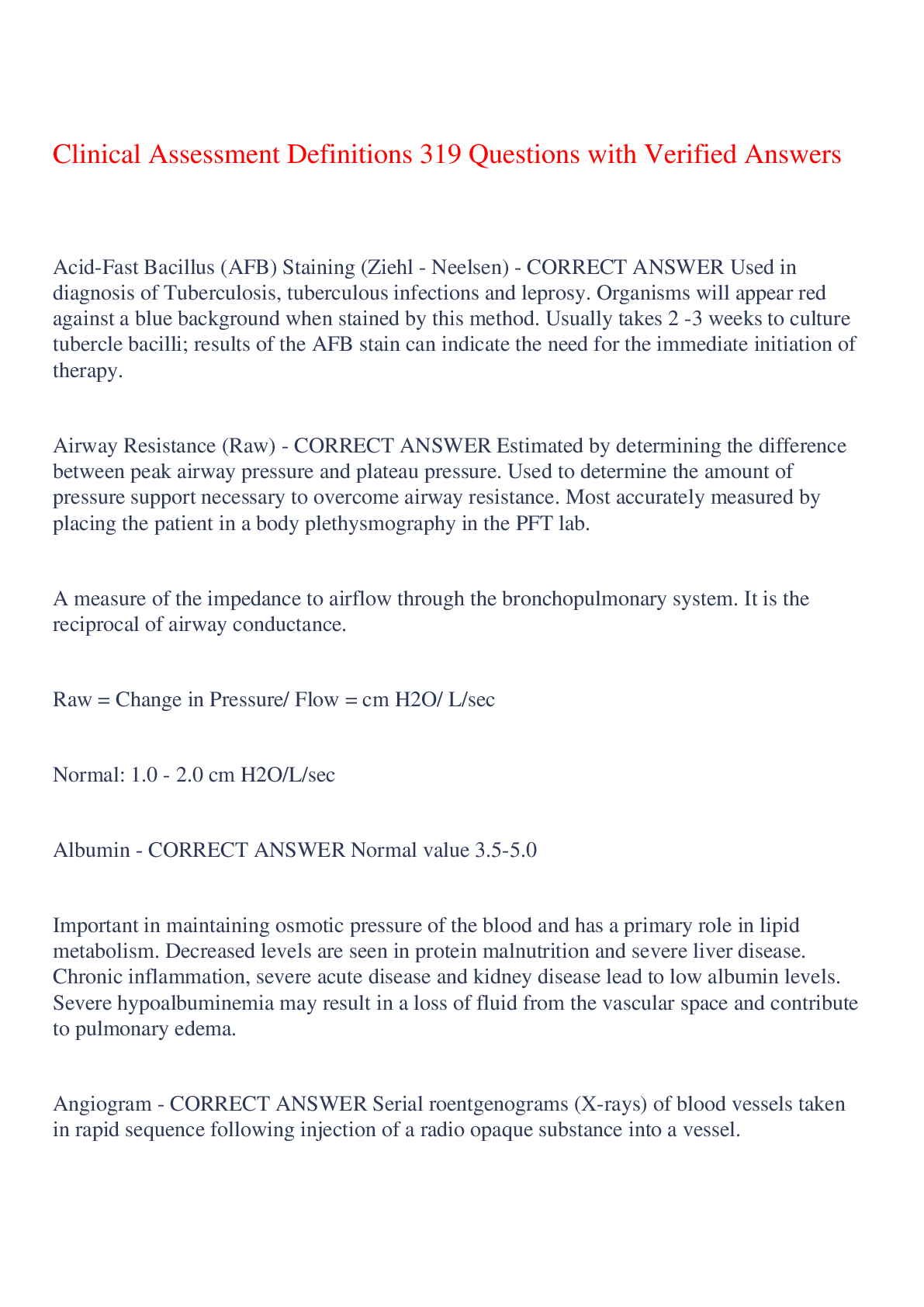

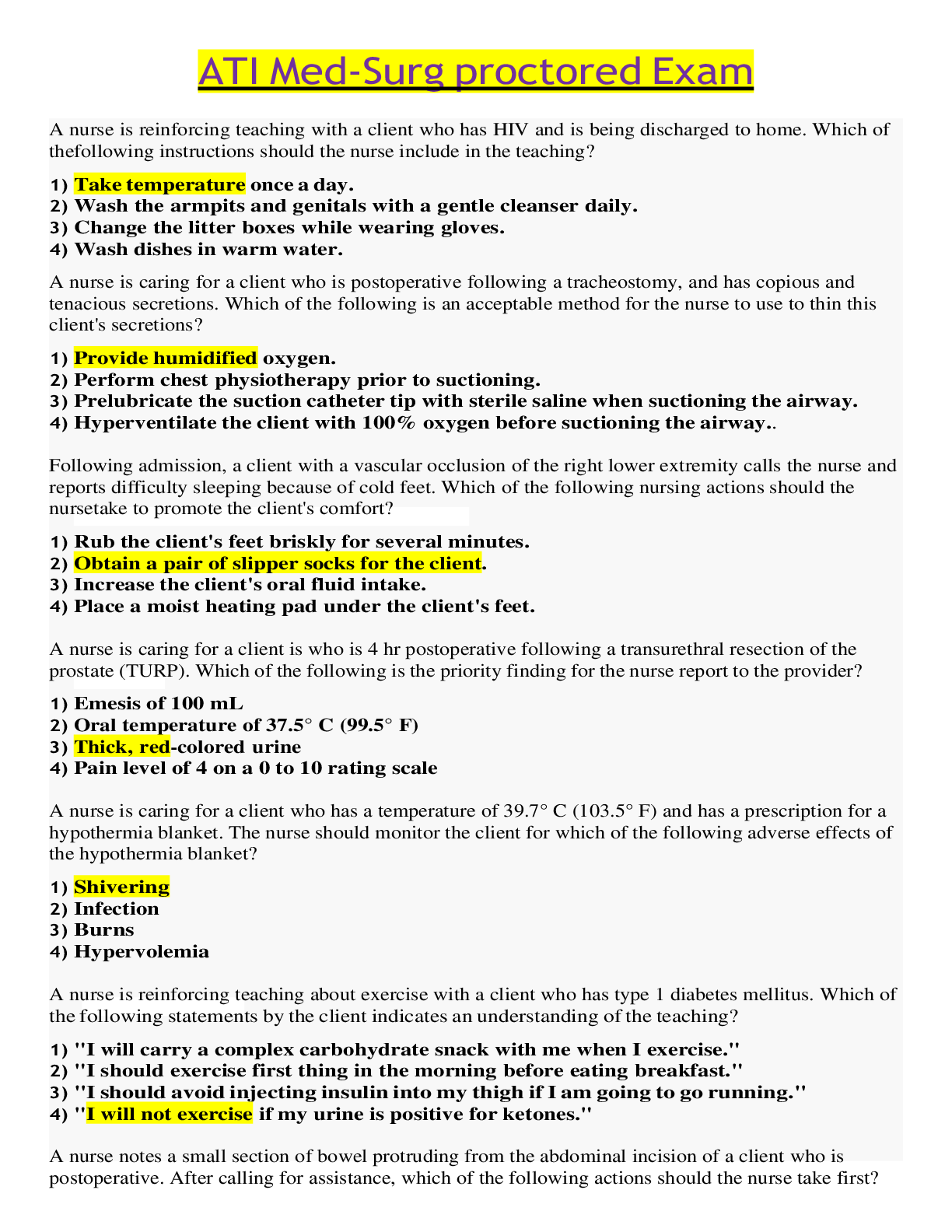
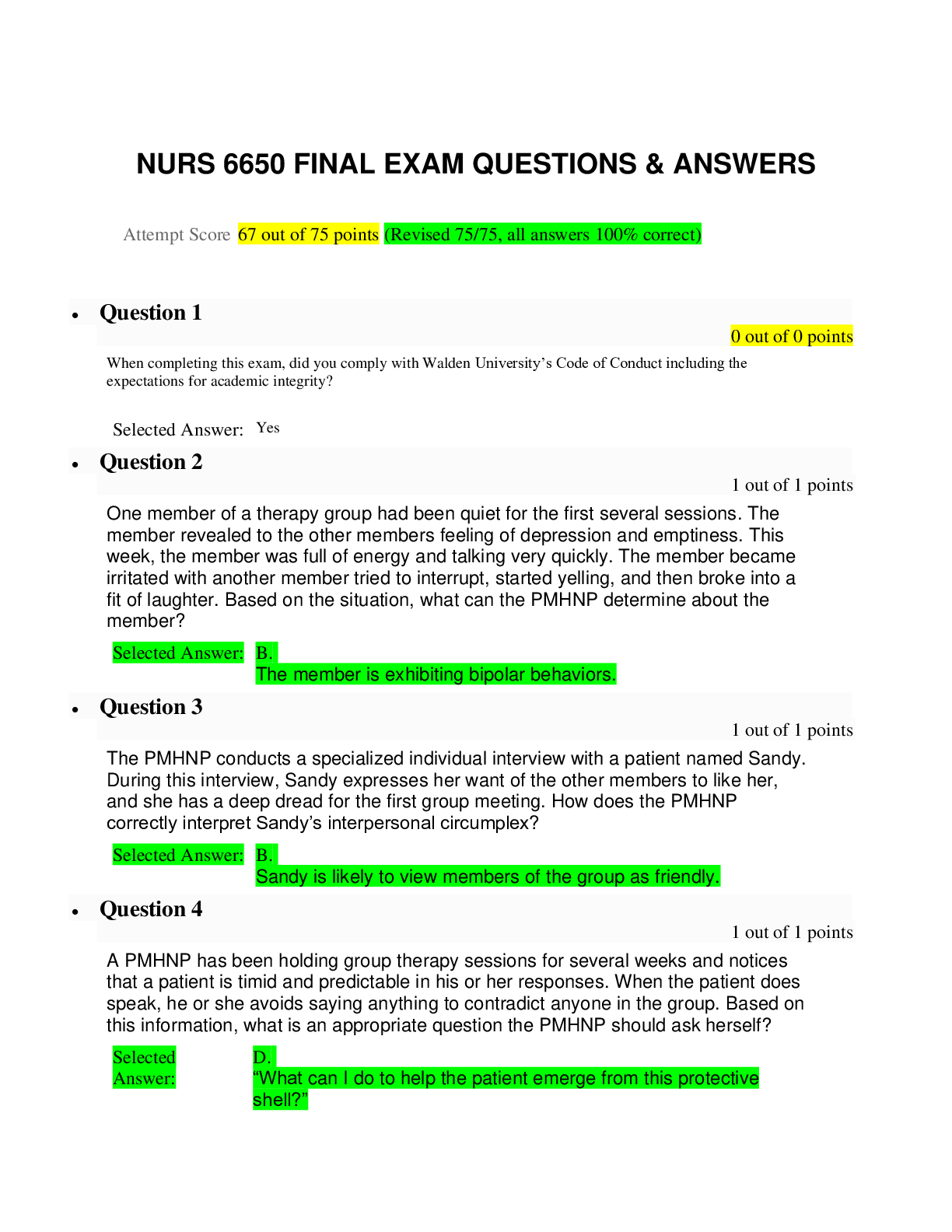
.png)
